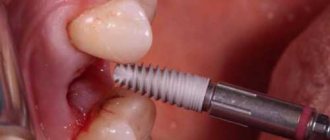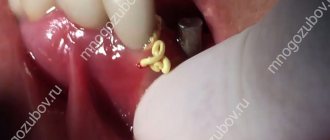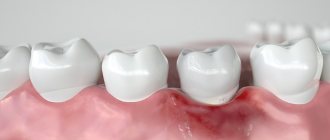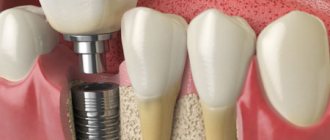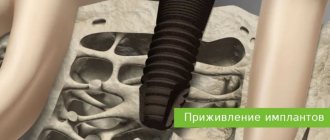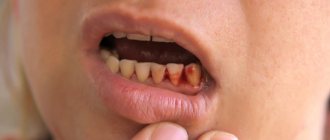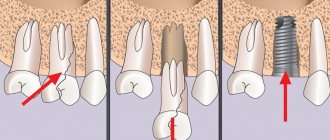What is autologous dental transplantation?
This is a unique surgical operation performed by doctors at our clinic.
Autotransplantation is a procedure in which a healthy tooth is taken from a patient from an area where it is less functional (wisdom tooth, supernumerary tooth). This tooth becomes a donor. It is transplanted to a place where there is a great need for it - if tooth extraction is required (severely damaged tooth, root crack, etc.). That is, autotransplantation is an alternative to traditional implantation. Instead of implanting an implant, your own natural tooth is implanted.
Attention: such a transplant is not possible in all cases; the indications will be determined at a personal appointment and after diagnosis.
Direction: Surgery and implantation
0/0
Autotransplantation is the transplantation of your own tooth. Photo before deletion
After treatment. We implanted a wisdom tooth in place of the extracted tooth.
Doctor: Shirnaliev Ulvi
Direction: Surgery and implantation
0/0
Autotransplantation is the transplantation of your own tooth. Photo before treatment.
A root crack was diagnosed and the tooth was removed.
We implanted a wisdom tooth in place of the extracted tooth.
Doctors: Unzhakova Yulia Kobozev Mikhail
Direction: Surgery and implantation
0/0
Autotransplantation is the transplantation of your own tooth. Before treatment (cracked root of the sixth tooth).
Tooth removed, fitting of wisdom tooth template.
We implanted a figure eight in place of the extracted tooth.
New tooth - after endodontics.
Doctors: Unzhakova Yulia Kobozev Mikhail
Cons of implants
Valentina
I wanted to place an implant non-surgically and immediately with a crown, but the doctors said that the risk of rejection was too high, and I needed to do a bone graft, and then a regular classic implant without load. It's a shame that the technology exists, but you can't use it. A bunch of conventions and contraindications.
Inna Vladimirovna
I have a low pain threshold, so after installing 2 implants I was forced to go on vacation at my own expense - there was no question of going to work - I lay flat for 4 days, drank and injected painkillers. Although my family is sure that I simply “cheated” myself. I'm happy with the result, but I don't know if I'll go again if necessary.
How does the autotransplantation process work?
- In order for the transplant to be successful, you need to make sure that the donor tooth is the right size for the socket of the tooth that needs to be removed. The doctor evaluates the shape and size of the donor tooth on a CT image.
- We scan the tooth and print a three-dimensional model of the tooth on a 3D printer. It is made of special plastic.
- The doctor tries on the future donor tooth (this happens even before extraction).
- Next, the dental surgeon atraumatically removes the decayed tooth. Places a 3D model of the future donor tooth into the socket and carries out the final fitting.
- The doctor then very carefully removes the donor tooth and moves it into the socket of the newly removed tooth. Places stitches and strengthens with a splint. The surgical part is completed. Next - inspections.
- You have had a tooth transplant. What is important to know? Recommendations from our doctors!
Cost of implant installation
Egor
I’m writing, maybe the information will be useful to someone. My teeth fell out early and I didn’t want to walk with a denture. But I always thought that I couldn’t afford the cost of implanting ALL teeth. I was smart enough to go to a consultation, and there they explained to me, a complete idiot, that if all my teeth are missing, then I don’t need to get 32 implants. Enough 4 at the top and 4 at the bottom. And prostheses are firmly attached to them. It is much cheaper and quite adequate in cost. This design for one jaw can be ordered from 120 thousand.
Alina
My employee installed an implant in a “budget” clinic for 25 thousand, when I was puzzled by finding a good deal, I found it for 18. They did everything perfectly, the service not only pleased, but really delighted. Once again I was convinced that everyone’s budget is different!
PROMOTION
Osstem dental implantation turnkey
18,000 rub.
Features of the rehabilitation period
After the operation, the implantologist will give detailed recommendations to the patient regarding care, regimen, and nutrition. Since the implantation was gentle, pain is usually mild or absent. Discomfortable sensations, as after a regular removal, go away on their own within 3-5 days.
Scrupulous adherence to medical instructions in the postoperative period ensures rapid and trouble-free healing and prevents the development of complications. Recommendations are conventionally divided into general and medical.
Dental transplantation: pros and cons
Although, at first glance, this technique has many advantages, there is no consensus on this issue in dentistry. The advantages of transplantation include the return of normal chewing of food, prevention of the development of bite defects, and restoration of the beauty of the smile. The key point is that these operations can be performed on children and adolescents who are contraindicated for implantation.
However, there are a number of features pointed out by doctors who are not entirely positive about this technique:
- there is a risk of tooth rejection - this happens in 5-20% of cases;
- in some patients, the roots of transplanted teeth resolve within 2-3 years;
- if the roots of the transplanted teeth fuse with the jaw directly, and not through the periodontal ligament, they will begin to deteriorate quite quickly;
- since wisdom teeth have a very branched root system, additional traumatic manipulations are required to engraft them in place of chewing teeth;
- the need for orthodontic correction.
It is worth noting that the success of engraftment is influenced by the patient’s age and the type of transplant - the follicle engrafts more successfully than an already formed tooth. However, transplants are successful in 80-95% of cases.
What are the alternatives?
The most inexpensive way to replace a missing tooth is to install a removable butterfly denture. But it is quite noticeable from the outside, does not restore chewing function well and does not hold securely, so it should only be considered as a temporary solution to the problem.
Another common method is a bridge, which before the advent of implants was the most popular way to replace a lost tooth. The design consists of connected crowns - the outer ones rest on living teeth, and the central one fits tightly to the gum and closes the void. But to install this prosthesis, you will have to sacrifice two healthy adjacent teeth by grinding them down. And bone atrophy progresses under the prosthesis.
The most optimal alternative is dental implantation. This is the restoration of the crown of a tooth on an implant, which is fixedly installed inside the jawbone, exactly where the root of the living tooth was. However, this treatment will take longer compared to autotransplantation, especially if bone needs to be built up first.
1 Tsukiboshi M, Yamauchi N, Tsukiboshi Y. Long-term outcomes of autotransplantation of teeth: A case series. Dental Traumatology, 2019
Characteristic signs of dental implant rejection
- Aching, cutting, throbbing pain in the area of implantation;
- Swelling of the gum tissue;
- Bleeding gums in the root/implant area;
- Swelling can gradually move to the lips, cheeks, pain can radiate to the neck and even the back of the head;
- Headache;
- Inability to chew food normally;
- Unpleasant odor coming from the mouth;
- Temperature increase;
- General weakness.
If these signs of non-engraftment appear in the first 7–10 days after installation, this is a physiological norm. If they persist, the pain increases, the condition worsens, this is an alarm signal - you need to urgently contact a specialist and take radical action.
How is the operation to remove an artificial implant performed?
The doctor may prescribe symptomatic treatment to the patient to relieve acute signs of inflammation. Treatment is aimed at preserving the implant.
If X-ray diagnostics show that the implant core cannot be saved, in this case it is necessary to perform an operation to remove it. The doctor performs the following actions:
- At the beginning of the operation, the patient is given anesthesia (local or general) to relieve pain in the surgical area.
- A temporary or permanent crown is removed/the prosthesis is removed.
- The tissue is cut to remove the implant.
- The implant is removed, and further measures depend on the protocol of the planned actions. If it is planned to re-insert the implant, an operation is performed to build up the bone, and the soft tissue is sutured. If the installation of a new implant is delayed, sutures are required.
It is important to determine the exact error and the main reason for the non-acceptance of the implant, perform removal, complex treatment, prevention, and then perform re-implantation.
Natural rejection of the implant by the body
The reasons for the natural failure of an artificial implant to survive may be:
- allergy to the material from which the implant is made;
- in case of weakened immunity;
- chronic diseases of the body, especially in the acute stage;
- bone injury in the area where the artificial implant is inserted;
- incorrect selection of an implant when the anatomical features of the jaw structure, soft tissues and other factors were not taken into account.
The so-called reimplantitis leads to destructuring of soft tissues and destruction of the patient’s bone. It manifests itself as follows:
- severe bleeding;
- swelling;
- implant mobility;
- detachment of gum tissue by more than a millimeter;
- the formation of purulent fistulous tracts in the cheek, in the lower part of the jaw;
- facial asymmetry;
- abrasion of the hard jaw bone;
- elevated body temperature.
It is important! If you consult a doctor in time, reimplantitis can be treated in a timely manner with powerful prevention, and surgery to remove the implant does not need to be performed. If the condition is advanced, in this case an operation to remove the implant is prescribed, and errors are corrected.
Doctor errors leading to dental implant removal
The most common mistakes that lead to implant removal are:
- insufficient diagnosis of the patient’s oral cavity condition, against the background of which the dentist did not identify and eliminate deviations before root implantation;
- lack of bone augmentation or sinus lift of insufficient bone tissue;
- insufficient calculations when choosing the size of the implant;
- an error in the operation, resulting in an infection in the open wound. There may also be poor quality treatment of the instrument with antiseptic solutions;
- the implant is not sufficiently integrated into the bone, and an abutment and crown have already been “placed” on it;
- implantation of an incorrect implant that could not withstand the load, or it was incorrectly distributed to the root;
- use of an implant of dubious quality;
- error in the treatment of pathologies of teeth and gum tissue;
- When the specialist performed the procedure, inaccuracies were made when attaching the implant root rod.
Disadvantages of implantation immediately after tooth extraction:
- increases the risk of implant failure
- there is an error in implant positioning
- used only in cases of exceptional compliance with clinical indications
Carrying out implantation immediately after tooth extraction does not always guarantee a high percentage of implant survival, due to its often loose fit to the inner walls of the alveolar bone. The survival rate directly depends on the primary stabilization of the implant, which is influenced by the quantity and quality of bone, as well as the shape and microstructure of the implant surface.
Also, the likelihood of conditions for implant rejection increases due to the lack of gum under the crown, as a result of which the area around the socket is exposed to pathogenic microflora of the oral cavity. reimplantitis develops .
The use of classical implantation techniques after tooth extraction and compliance with all stages of implantation provides the implant with favorable conditions for its engraftment in the bone and, thereby, minimizes the risk of complications and increases the percentage of successful implantation.


